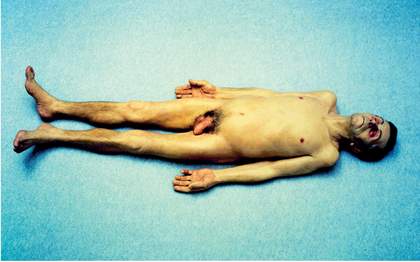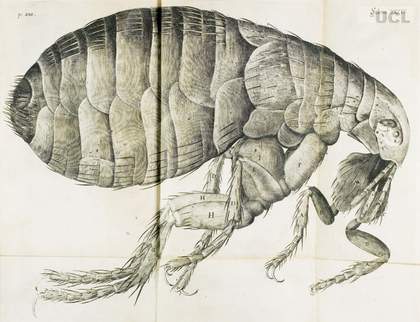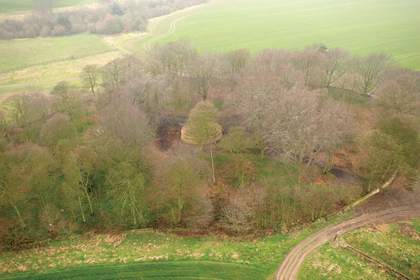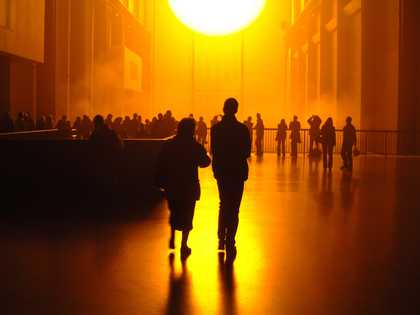HORST BREDEKAMP: When you curated Devices of Wonder at the Getty Museum in 2001–2, you showed Suzanne Anker’s installation Zoosemiotics, which consisted of sculptural representations of chromosomes hung on the wall, in front of which sat a spherical glass object filled with water. You could see through the glass on to the wall. It reminded me of an article you wrote where you argued that genetics in the biological sciences has a forerunner in the art practice of montage. In the installation, montage and genetics come together.
BARBARA STAFFORD: The glass of the globe also magnified the chromosomes (which looked like they were dancing on the wall), precisely at the same moment that it compressed and intensified the image. I think this begins to move in the direction of what we mean by the hyperreal – that is something which is artificially intensified, and forced to become more than it was when it existed in the real world.
HORST BREDEKAMP: So you define the term hyperrealism by a paradoxical existence, which means on the one hand compression or contraction, and on the other the revelation of the unexpected by magnification?
BARBARA STAFFORD: Yes. I would also add another component relating to work that I’ve recently done on our desires for transcendence that seems to go against everything we think about in our culture. Everywhere we look there appears to be this push beyond. This is Anker’s theme. It reminds me of something that Paul Virilio as well as the neuro-artist Warren Neidich have talked about – what they call phatic signifiers. Phatic images are ones that force themselves upon you whether you want to look at them or not. These range backward in time to figures such as the Medusa, and forward to contemporary advertising. Even ordinary images can be made more phatic when they are compressed, through magnification for example. This is exactly what happens in Anker’s water-filled globe: we become riveted by the cavorting ciphers rather than looking at the installation as a whole. In this I am put in mind of the illustration that appears in your lovely analysis in Thomas Hobbes: The Leviathan (2003) – an assemblage of bodies that makes up a pictorial representation of a public assembly, creating the state: a monstrous figure.
HORST BREDEKAMP: Indeed, this gigantic figure concentrates the whole society of citizens as cells of his body and empowers his appearance with something like a corporal force. Hobbes has developed a theory of semiotics which I think comes close to this power of images; concentration of something that thereby turns into an overwhelming existence. He argues that visual marks give you spaces for your memory, whereas signs force you to act. And that is why the frontispiece of The Leviathan is by definition not a symbol of the text, but, following your paradoxical definition of hyperreality, an instrument of activity that goes beyond pure visualisation.
BARBARA STAFFORD: If we look at the early work of Chuck Close, we have a nice contemporary example with the Hobbes image in mind. You see every pore, every strand of hair. I think there’s something quite platonic here. It’s almost a way of taking all of those features usually not valued, magnifying them and giving them a reality. It also gives them an ideality. This is the paradox that is elevated by the Gnostics – a kind of negative dialectics.
HORST BREDEKAMP: The way the details are painted, the product of all the details and the traits of this portrait give it another quality that is much more than the sum of what we see. I wonder if there is purely a semantics of shape which continuously is crossing the border of things, or if there is a jump from the individual to the serial at play.
BARBARA STAFFORD: There an emphasis on repeating the same subject in the series of self-portraits by Chuck Close. But where is the real subject? There is something self-generating about these multiples that is reminiscent of systems theory and cybernetics. But it always poses the identity problem: where do you stop and where is the real self? Perhaps this is another dimension of the hyperreal: that it perpetually deflects the question of where is the real in its overproduction of too many or too much, so that one is unable to make a decision.
HORST BREDEKAMP: It happens also in the work of Franz Gertsch, as in his series of portraits of Johanna (begun in 1983), then fifteen years later, Silvia (begun in 1998).
BARBARA STAFFORD: We could also include Ron Mueck or Charles Moore – sculptors who owe their sense of the surplus of reality to someone such as Duane Hanson. At some level, the hyperreal is also wrapped up with the insistently single and the singular. Close gives us the repeated – not the repetitive – single figure, and this valorisation of the eccentric, the idiosyncratic, comes, surprisingly, in an era that is decidedly non or anti-individualistic. In the body work of Nina Levy, for example, the protuberance of the genitalia, the redness of the hands, the scarring of the legs, or the oversized heads with their exaggerated features no longer belong to a classical or Romantic symbolic theory of identity, but, rather, to the intense empiricism of physical enumeration.

Ron Mueck
Dead Dad 1996–7
Mixed media
Image courtesy of James Cohan Gallery, New York © Ron Mueck
HORST BREDEKAMP: This solitary and magnified scrutiny of the single figure is all the more surprising after an epoch which deliberately denied the existence of originals, whether they be artists or poets. Individuality was out.
BARBARA STAFFORD: Yes, the hyperreal seems to me to be a very lonely category.When we conceive of hyperreality in terms of digital media, electronic media, interconnecting signals on the internet, or in biologically, but always computationally, intervened interactions, there is something profoundly solitary even in those seemingly collective gestures. Does this take us back to the Romantics in some way, or even further back?
HORST BREDEKAMP: The relationship between past and present is exposed in the most delicate philosophical way in the re-emergence of Romantic painting. Take the German Thomas Dillmann, who has recently become one of the most intensely intellectual painters in the tradition of Caspar David Friedrich. His foggy mountain paintings are superbly photorealistic and atmospheric, while at the same time encapsulating the entire tradition from Friedrich to Rothko.
BARBARA STAFFORD: Dillmann’s painting makes me think of recent misty installations, such as the phenomenologically-inflected The Weather Project 2003–4 that Olafur Eliasson created for Tate Modern. This immersive ambience was more than a reprise of Friedrich. It pervaded the senses of the viewer, washing him/her in a material fogginess that seeped into the pores – a sentiment amplified when reflected back (via a mirror) to the visitors lying on the floor looking up into the bathing mist. In addition to the loneliness that we spoke about, I wonder if the hyperreal makes one anonymous or perhaps unknown to oneself? Eliasson’s installations (and I think he shares this autonomous/anonymous effect with Andy Goldsworthy’s evanescences) are de-realisations. By this I mean they work to undo the person by foregrounding the situation in which people find themselves. This ambient work has the effect of pushing people who do not know one another into a common, heightened milieu. (Fog, mist, cave-like environments are conducive to producing a hallucinatory sense of more-than-reality.) Such sites are not productive of consensual experience; it’s not Hobbes’s conscious political assembly, but it’s certainly a conjoining situation.
HORST BREDEKAMP: I think this captures a host of reasons for the astonishing return of a Romantic milieu painting.
BARBARA STAFFORD: I think you are right in your perception that certain contemporary artists are interested in hyperreal atmospherics as a way of glueing things together that are no longer glued together naturally.
HORST BREDEKAMP: Yes, one cannot just talk of a simple, formal return of Friedrich. We can think, in contrast, of the outspokenly paradoxical and sarcastic paintings of Richard Phillips. He touches on the theme of genetics too, with his exaggerated rhetoric of bringing hyperrealistic beings into existence. For example, look at his Persia 1996, with its differently coloured eyes, painted albeit with the finesse of Dürer’s The Hare (1502). You feel you want to touch the fur of this little animal, but you are repelled by the eyes. But can one enframe this kind of surreal painting into what you defined as hyperrealism?
BARBARA STAFFORD: You seem to be raising the question of the hyperreal actually producing another creation – in the way that some of the new genetic artists such as Steve Kurtz or Eduardo Kac are attempting. You have written previously about the venerable tradition of the artist wishing to be a second creator. That old emulation occurred within the conventions of God as the primal artisan. But these new artists are cut loose from any norms and prior frameworks – including that of the individual. So I think when we’re in a category of genetic art, we’re in a category of morphed imagery that gets us into yet another class of the hyperreal – the production of that which is extreme and has not existed before.
HORST BREDEKAMP: As far as I understand, artists such as the SymbioticA Research Group or Kac say that scientists are not hyperrealistic enough. Certain genetic artists argue that they are forerunners of the alter deus, the second God, and so consider their art as outstripping the limits of art, as well as exceeding the frontiers of science. They are claiming a prerogative that has rarely been invoked since the Renaissance, namely that artists are scientists by virtue of their creations. Frank Fehrenbach recently showed that Leonardo, as a would-be creator of genetic art, used mercury to simulate movements in dead mice, so this is an enduring idea.
BARBARA STAFFORD: The relationship between the arts and sciences has been talked about for a long time, going back to Leonardo and forward to Suzanne Anker, Ellen Levy and the Critical Art Ensemble. But I think there is a palpable shift as well. Artists such as Natalie Jeremijenko or Simon Penny – who have degrees in robotics or engineering as well as fine arts – are now claiming that they are critical knowledge producers interested in social constructivist theories. I think such rigorous training pushes the art-science relationship into a hyperreal realm. The relationship between these former rivals becomes collapsed and therefore intensified. Since we’ve just hit on the topic of transgressing conventional boundaries, do you think we need to say something about pornography?
HORST BREDEKAMP: This is definitely a factor in Phillips’s work. I think it is significant that the abuse of children is a strong theme in contemporary painting. In fact, it’s fashionable as well as problematic. This is hyperrealism where the unexpected element both comes and does not come as a surprise. For example, in the paintings of Cornelia Renz or Justine Otto you have children portrayed on a large scale, and suddenly you perceive that these are both fragile and aggressive beings.
BARBARA STAFFORD: I would say that these images – as well as those by Inez van Lamsweerde – make reference to the phatic dimension of pornography. They play with this material precisely because of the way it grips your attention. They calculate our inability to resist looking.

A flea from Robert Hooke’s Micrographia 1665
© Courtesy UCL Library Sevices
HORST BREDEKAMP: But the problem is the more they want to force, the less they do so. The more forceful paintings are those where the addition of the dialectics of pornography and fragility comes as a surprise.
BARBARA STAFFORD: I think what you’re saying is that it’s difficult to be surprised by anything anymore. But Lamsweerde’s morphing of the lips of a child abuser on the abused child, for example, is effective because it takes time for you to realise what is incongruous about the composition. And then, as in the myth of Medusa, you are unexpectedly frozen by the horrible realisation. I have just finished reading Elfriede Jelinek’s The Piano Teacher, which is fascinating precisely because of her insight into the power and limitations of pornography. There is no satisfaction in the end. And perhaps this tells us something more generally about the category of the hyperreal. Somehow, as the Romantics recognised, it aspires to beyondness, but soon falls to earth. This deflationary trajectory characterises all of the images we have considered. Also in Jelinek, the use of pornography by the piano teacher in order finally to break through to some sensuous life doesn’t happen, not even in its most violent moments. Actually, all the examples we’ve discussed share this unsustainability.
HORST BREDEKAMP: This seems to bring us back to the painter as creator. It is worth looking at artists who deal with the particularity of painting grass. For example, the Gertsch series refers back to the famous images of grass by Dürer. Scientists and art historians have defined each type of grass, each aspect of this turf. But by explaining these tufts, nothing is explained. We again seem to have this concentration on the singular and yet an evasive sense of something that is not explainable by detailed rendition. This conundrum has bedeviled the great artist-illustrators of science such as the Italian miniaturist Gherardo Cibo (1512–1600) and the Netherlandish painter Joris Hoefnagel (1542–1601). Is there a history of hyperrealism from, say, Dürer and Hoefnagel to Gertsch and Close?
BARBARA STAFFORD: Yes, if one looks at somebody such as Hoefnagel, who used the wings of a libella to create a kind of collage, he was outnaturing nature. As did Bernard Palissy, the famous French potter, who created vivid life-casts of snails, snakes and beetles. The desire was somehow to preserve and give these marvels an added force by situating them in a new composition. Artisanal fabrication was a way of mastering God’s creations. Getting to know reality more deeply, paradoxically, produces more than reality.We are not just looking at a mayfly. It’s not just a quince. It’s not just a dried rose leaf. It’s not just a life-cast of a snail. Compression, operating in those seething platters of Palissy or crawling vellum pages of Hoefnagel, results in a more intense seeing experience.
HORST BREDEKAMP: With Hoefnagel you need a magnifying glass to see if the wings of the dragonfly are painted or real. The same ambiguity is developed in the use of media. For example, Goltzius’s Right Hand 1588 by Hendrick Goltzius (1558–1617) is seemingly a fantastic etching, but is, in fact, a drawing. He has faked the art of both etching and drawing by drawing an etching. It comes close to Hoefnagel’s example of drawing a wing of a libella, and on the next sheet in his book putting a real wing of the libella into the drawing, thereby faking the frontier between real-life object and art object.
BARBARA STAFFORD: This artisanal production of wonders, almost second wonders, is very much like looking at something under a microscope. (Think of the images in Robert Hooke’s Micrographia of 1665.) You are struck by two things: first, the absolute intensity of what you see and the fact that it doesn’t resemble anything you know; and secondly, even if you know what you’re looking at, say the capillary system in a leaf, that leaf becomes endowed with a hyperreality. It is both real and hyperreal simultaneously. And, to me, that is a very important tradition.
HORST BREDEKAMP: Neurobiologists tend to explain the relativity of seeing by arguing you have to control by touching. They neglect the fact that, in the theory of the optical, seeing is just one version of the haptic. These artists demonstrate that grasping a wing of a libella is something similar to gazing at the object of the drawn or given wing. There is a long tradition of hyperreality which goes against the distinction of seeing and grasping. So I would define one aspect of hyperrealism in these terms: that it continuously ironises the monopoly of either seeing or grasping.
BARBARA STAFFORD: I think you’re being too hard on the neuroscientists. Because our senses are so distributed as we stand up in our body, we forget that actually in our brain they are quite adjacent.
HORST BREDEKAMP: So in Hoefnagel there is exactly the knowledge of this procedure in the brain in a certain sense…
BARBARA STAFFORD: I think so. Today, there is this very interesting work being done examining the sensory systems. And synaesthesia has made a comeback. Happily so, since it helps to account for how the senses intensify one another. This is the mechanism behind hyperreality.
HORST BREDEKAMP: I think this has been overlooked too often. But in historicising the term hyperrealism, aren’t we doing the same job as Gustav René Hocke did in writing his The World as Labyrinth (1957), when he projected modern arts, namely Surrealism, back to Mannerism and through all the epochs?
BARBARA STAFFORD: There is no denying that there is an enormous difference between Hoefnagel, Palissy and Chuck Close. But I think there is a conceptual connection, oddly enough, with the Romantics and the failure of the sublime. The transcendent has not gone away. It’s just gone underground. The multiple faces of this subterranean transcendent are what we have defined as hyperrealism.


